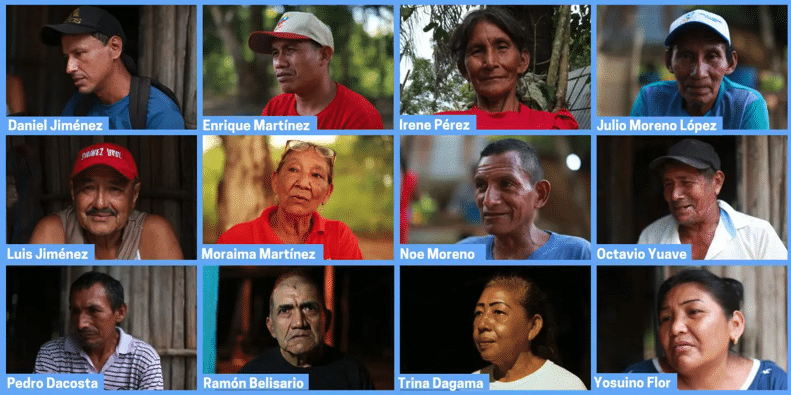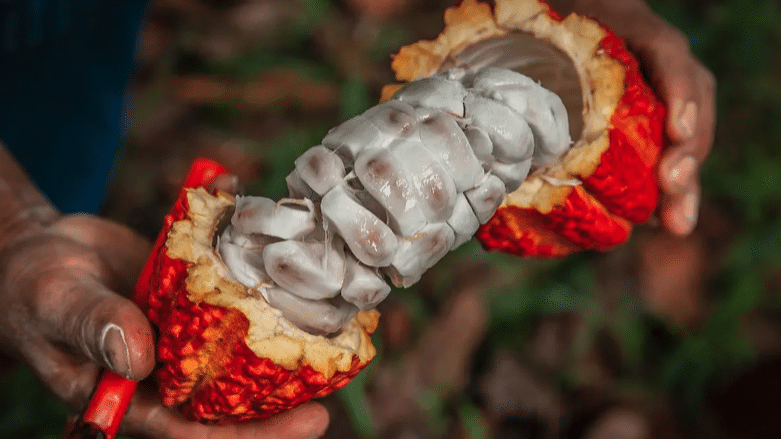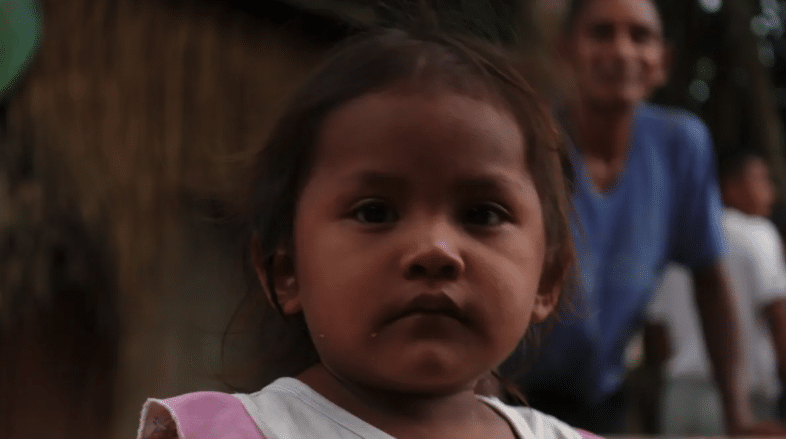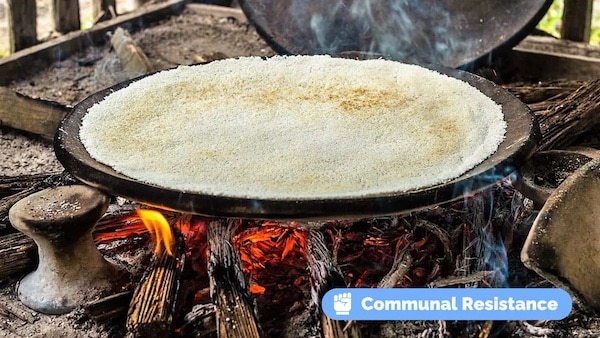Early in the last decade a set of communities along the Cataniapo River started to organize themselves to protect the river’s ecosystem and bolster their agricultural and handicraft production. A few years later, in response to Chávez’s call to build socialist communes, 15 communal councils in the area came together to form the Río Cataniapo Comune.
Today, approximately 1500 people participate in the commune. They come from various ethnic backgrounds, but the majority identify as Indigenous and some still practice common ownership of the land. The backbone of the commune’s food economy is yuca, which is used for making casabe [flatbread], mañoco [flour], and catara [spicy sauce]. The yuca is grown with traditional methods in small “conuco” plots alongside sugarcane, auyama [pumpkin], topocho[small plantain], and cacao. A growing handicraft economy focuses on producing mamure [vine] baskets and furniture.
The commune includes Indigenous communities with people from the Huo̧ttö̧ja̧, Kurripako, Baré, Jivi, and Yeral nations, alongside smaller non-indigenous or “criollo” communities. In Part I of this three-part series, members of Río Cataniapo discussed the commune’s roots in traditional Indigenous organization. In Part II, we delved into the culture of the Huo̧ttö̧ja̧ community in the Río Cataniapo Comune. In this final part we explore the economy and the impact of the U.S. blockade on the commune’s daily life.
[Note: In various interviews, participants spoke in their Indigenous language, relying on community translators to render their statements in Spanish.]

Daniel Jiménez is a founder of the Río Cataniapo Commune | Enrique Martínez heads up an UBCH and is part of the Las Pavas Communal Council | Irene Pérez, of the 5 de Julio-Las Pavas Communal Council, is an artisan and campesina | Julio Moreno López, of the 5 de Julio-Las Pavas Communal Council, is the community’s cacique and heads the Cuyeri School | Luis Jiménez is part of the Cucurital 2 Communal Council | Moraima Martínez is a spokesperson for the La Unión Communal Council | Noe Moreno is an artisan and a spokesperson for the 5 de Julio-Las Pavas Communal Council | Octavio Yuave is capitán of the Cucurital 1 Kurripako Communal Council | Pedro Dacosta lives in the Curripal 1 community | Ramón Belisario lives in the territory of La Unión Communal Council | Trina Dagama is education spokesperson for La Unión Communal Council | Yosuino Flor is part of the Cucurital 1 community. [Photo: Rome Arrieche]
Production
In the Río Cataniapo Commune, the conuco [small-scale plot] is the basis of the local economy, though fishing and hunting also play a vital role in supplying food. Additionally, the commune has a growing handicraft economy.
THE CONUCO AND YUCA PRODUCTION
Moraima Martínez: Our main crop in this commune is yuca, which is used for making casabe, our “daily bread,” and a variety of derivatives like mañoco [yuca flour] and catara [spicy sauce].
Yuca is also used to make yucuta, a drink that we offer to visitors. Sharing it is an expression of solidarity and reflects our deeply rooted communal spirit.
Yosuino Flor: To make casabe, we wake up long before dawn and head to the conuco to harvest the yuca, which we then bring to our casabera [casabe-making shed]. Some have to walk fifteen minutes with a 50-kilo load; others one hour or more. That’s how our days begin.
On returning, we peel and clean the yuca and let it ferment in water. The yuca is then grated or ground into a pulp and placed into a sebucán [a woven tube made from natural fibers]. The sebucán is stretched, which squeezes out the liquid from the yuca pulp. This liquid—called yare— is poisonous and must be removed. After pressing, the yuca pulp becomes crumbly. We spread it into thin circles on a budare [flat cooking surface placed over a hearth] to make a large flatbread.
We make casabe just as our grandmothers did and are proud to keep the tradition alive. The only difference is that we no longer grate the yuca manually.
Ramón Belisario: Our agriculture is centered on the conuco. The plots are rotated every four years due to the soil’s acidity and low nutrient content. This limits what we can grow; for example, we can’t cultivate corn or plantain. Instead, we focus on yuca, sugarcane, and ahuyama. We also grow topocho, copoazú [a tropical fruit], and cacao.
Irene Pérez: In my conuco, we have auyama, topocho, ají [chili], pineapple, tupriro [tropical fruit], along with mapuey and ñame [tubers]. However, yuca is our main crop which we use for making mañoco. We consume about half of what we produce, while the remainder goes to the Indigenous market [in Puerto Ayacucho] on Saturdays. The revenue from the sales allows us to buy the salt and oil that we need.
Yosuino Flor: We manage the entire casabe production process ourselves—from growing the yuca and producing the casabe to taking it to market. We also build our own casabera [casabe preparation shed] and make all the production tools, including the catumare [yuca-carrying chest] and sebucán.
Pedro Dacosta: Taking our production to market on Saturday isn’t easy. We have to transport everything across the river on a small bongo [wooden canoe] that we collectively bought a year ago.
With a weekly production of about 480 casabe flatbreads, each weighing around 700 grams, that means transporting over 300 kilos in a small boat… and then taking the casabe to Puerto Ayacucho. Saturdays start very early for us!
Moraima Martínez: In the Río Cataniapo Commune, the conuco is the backbone of our economy. Still, fishing and hunting are vital to many households as well. Men often hunt picure[aguoti], lapa [paca], venado [deer], pajui [tropical bird], and danto [tapir] using traps, bows, or rifles. Additionally, Indigenous communities capture araña mona [large spider], culebra de agua [water snake], toads, and frogs.
Our communities along the Cataniapo River are also very involved in fishing, catching a variety of fish such as cabeza de manteco [butterfish], guabina, corvina [croaker], bagre rallao [striped catfish], and pámpano.

Copazú, a tropical fruit. (Photo: Rome Arrieche)
THE CUYERI SCHOOL
Julio Moreno López: Basket-weaving is an ancestral craft for the Huo̧ttö̧ja̧ people. It is a tradition passed down through generations. However, I also trained at INCES [state-run technical school], where I learned new skills in weaving mamure, which is known as bejuco[natural fiber] by the sabararí [non-indigenous] people. Now, I produce mamure furniture in our workshop.
But our workshop is more than just a place for creating market-ready furniture; it has become the Cuyeri School, a place to pass down our knowledge and culture. Each piece woven in the school carries the story of our people, honoring our roots while preserving our traditions for younger generations. We’re safeguarding knowledge while creating economic alternatives for the youth in Las Pavas.
In the Huo̧ttö̧ja̧ language, cuyeri means “book” or “notebook.” That’s what the school is: a living book.
There are currently twelve kids from the community learning the trade here, and we hope the initiative will grow. Recently, Minister of Communes Angel Prado visited and pledged his support for the project.

A coach made in the Cuyeri School. (Photo: Rome Arrieche)
Impact of the blockade
The impact of the unilateral coercive measures [aka sanctions] on the Venezuelan pueblo has been devastating. Here, we learn from the communards of Río Cataniapo about how the blockade has affected their lives and how they’ve organized to overcome these obstacles.
Enrique Martínez: They [the imperialists] say that our country is sanctioned because of the character of our government. One day they argue that it is about the elections, another day they say that it’s about the nationalization of PDVSA, and yet another day they say that it’s about human rights. In truth, the blockade was set in place because the U.S. government and the local capitalists don’t like our socialist revolution. Frankly, it’s all very simple.
Then there is an added incentive or motive for them: they want our natural resources, our oil, our water, and our minerals. They are hungry for what we have. They cannot stand that our project is about sovereignty.
The blockade has been brutal. We have suffered a lot here, though significantly less than people in the big cities, who don’t have a conuco to grow their own topocho or auyama.
In the commune, we didn’t sit idly when the blockade hit. We know that the revolution made us visible and we understand that organization and communal power will eventually undo the pains and suffering that the U.S. government has brought upon us. Over these years one thing has become clear: “Solo el pueblo salva al pueblo” [only the pueblo will save the pueblo].
Ramón Belisario: I’m deeply committed to the revolution; it has made us visible and heard; it generated a constitution that empowers us; and it gave us the communes. You could even say it brought us the sanctions, which have made us more resilient and creative and have taught us patience.
I admire President Maduro greatly for standing firm and not giving in. But more than that, I admire the Venezuelan pueblo; we’ve organized and we’re rising out of the ashes like a phoenix.
Octavio Yuave: The blockade hit urban areas really hard, but rural communities were less affected. Here in Cucurital 1, we control the entire casabe production cycle. We grow yuca, harvest it by hand, and process it traditionally. We don’t rely on outside supplies, and we also hunt and fish, which gives us autonomy. The market doesn’t rule our lives, that’s why the blockade’s impact has been lighter on us.
That said, under the blockade, getting to the hospital became difficult because of fuel shortages, and medicines were often out of reach. Thankfully, fuel distribution is more stable now, but getting medicines is still hard. However, all this has made us turn to our reserve of natural ancestral cures, which have become increasingly important in recent years.
Pedro Dacosta: During the hardest times of the blockade, we grated yuca manually because we couldn’t get fuel for the cigüeña [mechanical grader]. That was really exhausting. It was also hard to get basic goods, since it became difficult to reach Puerto Ayacucho to sell our production and buy the salt, sugar, and oil that we need.
During the worst of it, our production dropped by more than half; we produced mainly for subsistence, and we relied more on hunting and fishing. Now our production has recovered. It is not on par with pre-blockade times, but is significantly better than three or four years ago.
Ramón Belisario: The blockade didn’t keep us from producing, but it left us with worn-out tools. Most of us need equipment to keep working the land—especially string trimmers, hoes, files, and other essential tools. Many of us are down to the most basic tools; my machete, for instance, is so worn out that it is no sharper than a dull kitchen knife.
Enrique Martínez: The economic war on Venezuela goes back to the early days of the revolution. However, the blockade that began almost ten years ago has been especially cruel: the entire population, particularly the poor, suffered its consequences. However, I think Indigenous communities have been less affected than the sabarí. Our small-scale, non-industrial agriculture for self-sustenance shielded us a bit. We grow yuca for making mañoco and casabe, we fish and hunt. Nature provides for us, and in return, we care for her.

A Huo̧ttö̧ja̧ girl [Photo: Rome Arrieche]
SOLUTIONS
Trina Dagama: The blockade forced us to return to practices that were nearly forgotten, and it brought the youth back to the campo. Before, many young people wanted to become professionals and to leave behind our traditional ways.
Today, however, they understand that life, traditions, nature, and production are all linked together. Now the youth understand that the food we eat comes from our work as direct producers, and they’re showing renewed interest in learning and working the land.
Moraima Martínez: Every family has a conuco in the Río Cataniapo Commune, so we never went hungry, but the economic war has affected our bodies in many other ways.
At the same time, the blockade has promoted the recovery of practices like making soap from tree bark and making yuca arepas, the ancestor of the modern processed cornflour arepa.
Finally, when gasoline was scarce, we walked everywhere—to assembly meetings, community gatherings, and even to Puerto Ayacucho for supplies. Now fuel is more stable and we’ve learned ways to make do with what we have.
Luis Jiménez: There is no part of the Venezuelan territory that hasn’t been affected by the blockade: almost overnight we lost access to medicine, technology, and fuel. It was dramatic. If I look back to 2018, 2019, or 2020, I now realize that our conditions were no different from those in a war.
For example, people with diabetes who needed dialysis would have to travel to San Fernando de Apure because local equipment couldn’t be maintained. The journey was already long and challenging, but without fuel, it became a terrible ordeal, with many unable to do it. We lost many loved ones; they are the victims of this economic war.
Thankfully, the government has managed to restore the dialysis equipment in Puerto Ayacucho, but fully reactivating the hospitals is still a pending task.
Noe Moreno: The blockade pushed us to return to ancestral ways to treat illnesses. I know which plants and leaves heal, and people now come to me when they’re sick. If someone can offer something in exchange, I accept, but it’s not a requirement.
I learned the trade from my grandparents, who in turn learned it from theirs. This knowledge—they said—can be traced back to the gods.
Luis Jiménez: Step by step, we found ways to solve our problems: we made arepas from yuca, not cornflour, and returned to using topocho and yuca starch drinks to nourish the young.
We’ve struggled most with access to medicine, and also seen our roads, hospitals, and schools fall into disrepair—due to limited resources and because urban areas are privileged over rural ones. There are many pending tasks, but we are beginning to see the light at the end of the tunnel. The commune has been key to finding solutions.
Daniel Jiménez: Chávez said that communes must be productive, and he was right. The blockade has proven this. Venezuela’s food sovereignty was—and still is—fragile, but the communes show that producing for the people is possible. Without production, there’s no commune; without the commune, there’s no country!

